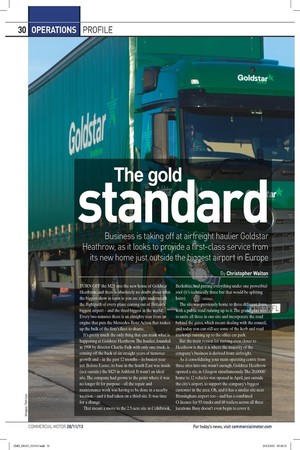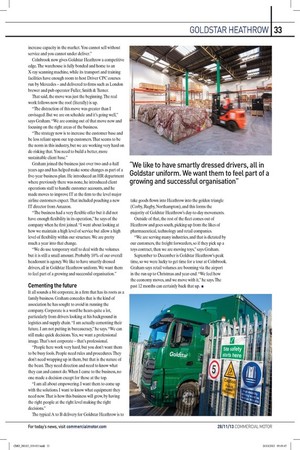The gold standard
Page 23

Page 25

Page 26

If you've noticed an error in this article please click here to report it so we can fix it.
Business is taking off at airfreight haulier Goldstar Heathrow, as it looks to provide a first-class service from its new home just outside the biggest airport in Europe By Christopher Walton
"TURN OFF the M25 into the new home of Goldstar Heathrow, and there is absolutely no doubt about what the biggest show in town is: you are right underneath the flightpath of every plane coming out of Britain's biggest airport — and the third biggest in the world. Every two minutes there is an almighty roar from an engine that puts the Mercedes-Benz Actros that makes up the bulk of the firm's fleet to shame.
It's pretty much the only thing that can mask what is happening at Goldstar Heathrow. The haulier, founded in 1998 by director Charlie Fulk with only one truck, is coming off the back of six straight years of turnover growth and — in the past 12 months — its busiest year yet. Before Easter, its base in the South East was inside (not outside) the M25 in Ashford. It wasn't an ideal site. The company had grown to the point where it was no longer fit for purpose — all the repair and maintenance work was having to be done in a nearby location — and it had taken on a third site. It was time for a change. That meant a move to the 2.5-acre site in Colnbrook, • is is
Berkshire, and putting everything under one proverbial roof (it's technically three but that would be splitting hairs). The site was previously home to three different firms,
• "'Itith a public road running up to it. The grand plan was to unite all three in one site and incorporate the road behind the gates, which meant dealing with the council, and today you can still see some of the kerb and road markings running up to the office car park.
But the main reason for moving even closer to Heathrow is that it is where the majority of the company's business is derived from: airfreight.
As if consolidating your main operating centre from three sites into one wasn't enough, Goldstar Heathrow opened a site in Glasgow simultaneously. The 20,000ft= home to 12 vehicles was opened in April, just outside the city's airport, to support the company's biggest customer in the area. Oh, and it has a similar site near Birmingham airport too — and has a combined 0-licence for 93 trucks and 68 trailers across all three locations. Busy doesn't even begin to cover it.
MD Paul Graham (pictured on previous page) says: "Glasgow came along as a complete sideswipe. It wasn't a case of thinking 'oh, let's open in Glasgow' or thinking about the strategic direction of the company. It was at the request of a client of ours and, because of the nature of this business, [it works].We are flexible and agile and want to help out anyone we can. "The real reason for moving down here was growth," he explains — the firm posted a turnover of £11.95m for
the financial year ending 31 March 2013, and a pre-tax profit of £716,000. In the previous financial year its turnover was £11.8m and pre-tax profit was £829,490. "Where we were, we could not grow. We were restricted. Not just on 0-licence and the legal side of things: we could not grow because we were at capacity. We could not sell any new business and we were consolidating what we had got. So we were looking for a new facility to increase our 0-licence, go out and sell and
increase capacity in the market. You cannot sell without service and you cannot under deliver."
Colnbrook now gives Goldstar Heathrow a competitive edge. The warehouse is fully bonded and home to an X-ray scanning machine, while its transport and training facilities have enough room to host Driver CPC courses run by Mercedes — and delivered to firms such as London brewer and pub operator Fuller, Smith & Turner.
That said, the move was just the beginning The real work follows now the roof (literally) is up.
"The distraction of this move was greater than I envisaged. But we are on schedule and it's going well," says Graham. "We are coming out of that move now and focusing on the right areas of the business.
"The strategy now is to increase the customer base and be less reliant upon our top customers. That seems to be the norm in this industry, but we are working very hard on de-risking that. You need to build a better, more sustainable client base."
Graham joined the business just over two-and-a-half years ago and has helped make some changes as part of a five-year business plan. He introduced an HR department where previously there was none, he introduced client operations staff to handle customer accounts, and he made moves to improve IT at the firm to the level major airline customers expect. That included poaching a new IT director from Amazon.
"The business had a very flexible offer but it did not have enough flexibility in its operation," he says of the company when he first joined. "I went about looking at how we maintain a high level of service but allow a high level of flexibility within our structure. We are pretty much a year into that change.
"We do use temporary staff to deal with the volumes but it is still a small amount. Probably 10% of our overall headcount is agency. We like to have smartly dressed drivers, all in Goldstar Heathrow uniform. We want them to feel part of a growing and successful organisation." Cementing the future
It all sounds a bit corporate, in a firm that has its roots as a family business. Graham concedes that is the kind of association he has sought to avoid in running the company. Corporate is a word he hears quite a lot, particularly from drivers looking at his background in logistics and supply chain. "I am actually cementing their future. I am not putting in bureaucracy," he says. "We can still make quick decisions. Yes, we want a professional image. That's not corporate — that's professional.
"People here work very hard, but you don't want them to be busy fools. People need rules and procedures. They don't need wrapping up in them, but that is the nature of the beast. They need direction and need to know what they can and cannot do. When I came to the business, no one made a decision except for those at the top.
"I am all about empowering. I want them to come up with the solutions. I want to know what equipment they need now. That is how this business will grow, by having the right people at the right level making the right decisions." The typical A to B delivery for Goldstar Heathrow is to
take goods flown into Heathrow into the golden triangle (Corby, Rugby, Northampton), and this forms the majority of Goldstar Heathrow's day-to-day movements.
Outside of that, the rest of the fleet comes out of Heathrow and goes south, picking up from the likes of pharmaceutical, technology and retail companies.
"We are serving many industries, and that is dictated by our customers, the freight forwarders, so if they pick up a toys contract, then we are moving toys," says Graham. September to December is Goldstar Heathrow's peak time, so we were lucky to get time for a tour at Colnbrook. Graham says retail volumes are booming via the airport in the run up to Christmas and year-end. "We feel how the economy moves, and we move with it," he says. The past 12 months can certainly back that up. •
eeping t e eet green
Goldstar Heathrow's fleet is all Mercedes-Benz. "Last year we went and purchased 12 new tractor units," says MD Paul Graham. The units, all Actros, were sourced from Rygor Commercials, expanding the firm's allMercedes fleet to 75. "That was a massive investment," he says. "I don't think we'd sold any equipment prior to me arriving and it was kind of old. [The investment followed] an analysis of workshop and maintenance and how many times vehicles were off the road. It was those hidden costs that had not been looked at before and we found out that those old vehicles were costing us money. They
were well maintained and great-looking trucks, but purchasing the new trucks has had a great impact on the organisation." Because of the nature of airfreight, Goldstar Heathrow
uses roller-bed trailers on the fleet. They can be tricky to maintain because splinters from pallets can get caught in the roller mechanism.
"We've bought 16 new trailers, all roller beds from SDC, and they are coming over the next six weeks. They cost a bit extra because they are roller-beds; we hire a lot of trailers, but it is very hard to hire equipment like that," says Graham. The high maintenance of the trailer fleet is part of the thinking behind bringing the workshop facilities into the same operating centre. "The workshop is a big concern," he says, "but it allows us to control our maintenance schedules and means that trucks aren't off the road for long."
It's vital for Goldstar to stay on top of its repair and maintenance as trailers mean money. "The roller-bed for us has a dual use," says Graham. "You can use it to move kilos around the airport via airfreight pallets but you can also use it to go up the road with the rollers down, shipping pallets around."







































